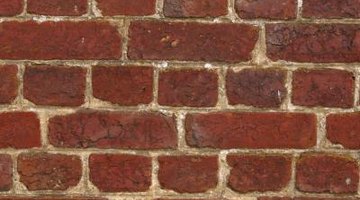How to Build a Brick Foundation
Bricks for building structures have been around since ancient times. They remain among the strongest and most durable building materials you can find. The decision on whether to use bricks to lay a foundation depends on the structure. For smaller structures such as a garage or outbuilding, or a decorative element like a wall, bricks are a suitable and attractive choice. Common brick laying techniques are used to set the foundation.

Step 1
Prepare the ground for the brick. Dig a trench at least 6 inches deep for a small foundation. For a larger foundation, the depth and thickness needs to be determined according to the size of the wall it will support. For example, a wall that is a single thickness of brick needs a foundation 2 brick courses deep. The trench will need to be 6 inches deep to accommodate the height of both layers of brick and the mortar. This will bring it to ground level. A course is one line or row of brick running the full length of your wall. For 2-brick thickness, the foundation needs to be 4 courses deep, and graduated in height. The main idea is to support the weight of the wall adequately.
Step 2
Dig the trench for the wall by hand. In this case we will use the 1-brick wall thickness as an example. Dig the trench 6 inches deep and one brick length wide. Since bricks vary in length, be sure to use the bricks you have to measure with. Start at the beginning of your wall and run the chalk string line down the center. Use this as a guide to dig the trench, checking it frequently to ensure that it is straight.
Step 3
Check the bottom of the trench to make sure it is level. Adjust it as needed.
Step 4
Set the first line of brick. Begin by laying one brick at the outer corner as a header, or the short edge of the brick facing you. The next brick will be a stretcher, or the long side of the brick facing you. Place them two deep, one in front of the other, to fit the length of the first brick. The bottom row will alternate this way the entire length. Set them by swiping a clump of mortar along the side facing the brick that will be set next to it. Push the next brick into the mortar so that you end up with a 1/2-inch mortar joint between them. Scrape away excess if needed. Try not to put too much mortar on, and don't dig down into the joint.
Step 5
Lay the second course by planting mortar on top of the first course of bricks where your first two bricks will go. You want to end up with an even mortar joint of 1/2-inch between courses. Smooth the mortar with a loose sliding motion. Swipe the back side and right edge of the first brick and set it in place. Do not push or pull the brick. Simply set it into the mortar without dragging it around. If you drag the bricks you disturb the mortar bed.
Step 6
Add a dab of mortar to just the right end of the next brick and set it behind the first brick. This course is 2 bricks deep. The bricks are laid length-wise, as stretchers, from end to end. There are no cross-wise, or header bricks, in this course. Continue adding mortar and setting the bricks all the way across. You now have two courses. The bottom course alternates a header brick, two stretchers, a header, two stretchers and so on. The second is two stretchers all the way across.
Step 7
Let the foundation cure before adding the weight of the wall. For this wall the maximum thickness is one brick wide. For heavier walls that are two or more bricks wide, consult the brick manufacturer for the foundation thickness.
References
Tips
- Check with your local building department for codes regarding brick foundations.
Warnings
- It is not recommended or common to use brick foundations for home structures, and building codes generally do not allow for this.
Writer Bio
Caprice Castano recently left the field of construction management to operate her own contracting business and spend time developing her writing career. Current projects include freelance writing for Internet publications and working on novel-length fiction.
Photo Credits
- Hemera Technologies/AbleStock.com/Getty Images
More Articles



